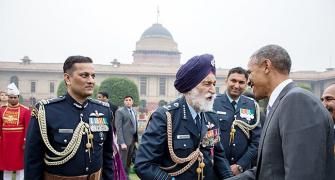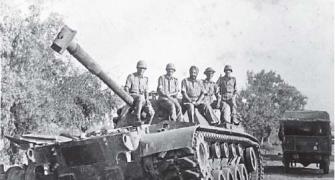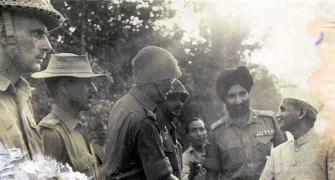Claude Arpi reveals how Wing Commander Jag Mohan Nath won a second Maha Vir Chakra in the 1965 War.
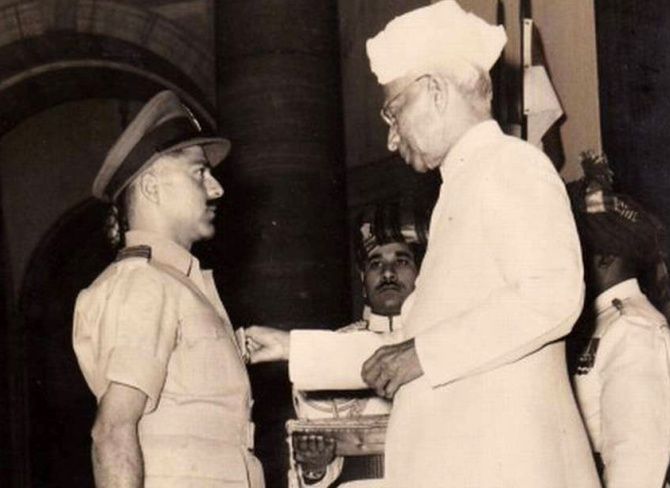
The Indian Air Force is in the news for the exploits of the anonymous Mirage-2000 pilots who conducted a raid on a terror camp in Pakistan.
The shooting down and subsequent three-day captivity of Wing Commander Abhinandan Varthaman, who, with his Mig-21 Bison shot down a Pakistani F-16, also got a lot of coverage.
It is perhaps the right time to salute the feats of the first Indian military officer to be twice awarded the Maha Vir Chakra, India's second highest honour for gallantry.
After describing his sorties over Tibet in the first segment of an exclusive interview conducted at his Juhu, north west Mumbai home, Wing Commander Jag Mohan 'Jaggi' Nath describes to Claude Arpi his daylight missions over Pakistan during the 1965 War.
Wing Commander 'Jaggi' Nath reveals the background of the operation which led to his second MVC. Some explanations have been added in italics.
It started after Pakistan had already failed with Operation Gibraltar (external link) in August 1965 in Kashmir (Operation Gibraltar was the codename given to Pakistan's plan to infiltrate into and take control over Kashmir by starting a rebellion against India's rule), then Pakistan decided to start Operation Grand Slam,(external link) (a plan drawn up by the Pakistan army, in May 1965, to attack the vital Akhnur bridge in Jammu. The bridge was not only the lifeline of an entire infantry division posted in Jammu and Kashmir, but could also be used to threaten Jammu, the vital logistical hub for the Indian forces).
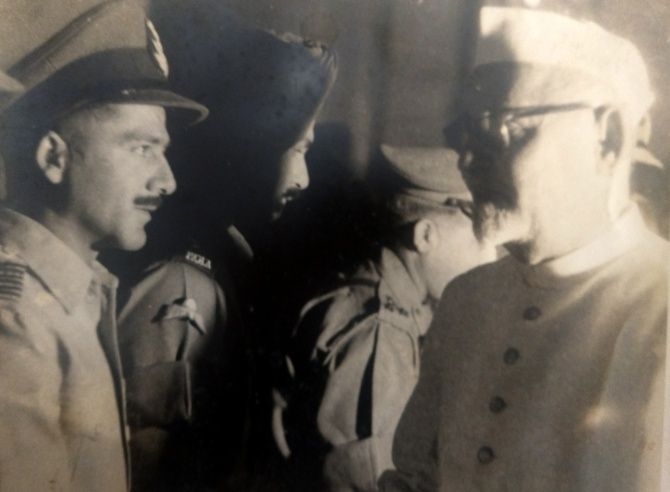
"The Pakistanis were given us a beating; the Indian tanks, though very close to Sialkot, were stopped. After Operation Gibraltar, I used to make daily sorties to see how the Pakistan forces were positioned."
"The cameras we were using were so good we could read the number plates! We could see human beings, like with the U2 cameras (used by the Americans). Our cameras were really high resolution cameras.'
The soon--to-be-90 wing commander digresses for a moment: "Of course, the Americans could use their U2 or the SR71 (The Lockheed SR-71 'Blackbird' is a long-range, Mach 3+ strategic reconnaissance aircraft that was operated by the US air force). Can you imagine it was a plane faster than a bullet? It was an amazing plane."
"We had landed into problems in Akhnur; the Pakistanis tanks were coming in and giving us problems. I knew what was happening because I had daily runs; the problem in our army is that they are restricted by the orders of the government. The army chief (General J N Chaudhuri) had to get clearances (for a move); (in the air force), we did not have these problems."
To explain the issue, Wing Commander Nath shows me a picture of the then air chief -- later the Marshal of the Indian Air Force -- Arjan Singh with his arm around his shoulder. "He told me, 'You are my foster son'. I told him, 'If it was not for you, I would not be alive today'."
Wing Commander Nath refers to an Indian mole at air headquarters in Delhi. "One plane got shot down because of a compromise in security. Pakistan had prior notice of our plane flying over Pakistan on April 10, 1959."
In another interview, the wing commander recounted: 'In the IAF there was a mole, that too at a very senior level in the form of an officer in the Western Air Command who controlled all the flight movements of ours. He'd give Pakistanis all they wanted and that is how when our reconnaissance plane went over Pakistan on the morning of April 10, 1959, the pilot found the PAF Sabres actually waiting and obviously bombed him.
'When we found out, the officer, a Group Captain, was thrown out. This event helped us become tighter and more secretive.'
At that time, Arjan Singh had just taken over as acting Air Officer Commanding-in-Chief (AOC-in-C) of the Western Air Command in Delhi.
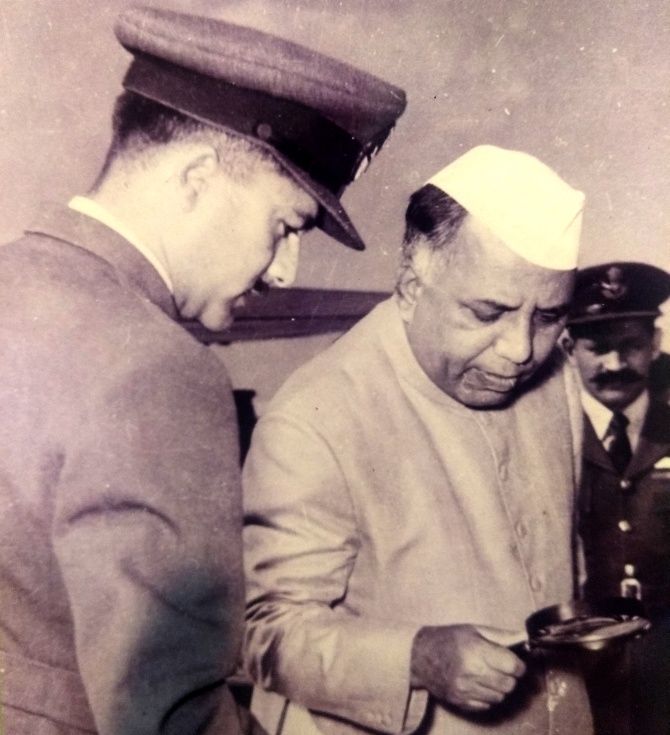
After having explained why in 1965, he was getting his orders directly from Arjan Singh, the then chief of air staff, Wing Commander Nath returns to the operation. "All the requirements came from the army. Every time something would take place, Arjan Singh would say, 'Send reconnaissance, send reconnaissance'."
"Arjan Singh had given me a code name, 'Professor' and would directly assign to me missions."
"During the 1965 War, like in 1962, the sorties that we did every day gave us the entire picture (of the enemy's forces)."
"Every day, we would get a briefing and do sorties. We had a complete picture how the war was proceeding."
"I had a clear picture of what was going wrong anywhere on any front."
You were providing the information to whom? To B N Mallik, the Intelligence Bureau director, to the air chief?
The information was going directly to the army chief; in 1965, it was General J N Chaudhury.
While the operations were going on, the army chief used to send his requirements to the air force; (for example) how the Pakistanis were moving or if they were not.
It would have been difficult (to take decisions) without knowing what was going on the other side of the border, how the Pakistanis were progressing.
There was no other way to get this information, but from the records of the reconnaissance planes.
Pakistani foreign minister Zulfikar Ali Bhutto and the army chief had planned Operation Gibraltar; (at the beginning) they finished off so many of our Vampires that we had no option but to bring our air force (in the war).
It was the time Nur Khan was brought in. (Air Marshal Malik Nur Khan was the commander-in-chief of the Pakistan air force. During the war with India in 1965, Nur Khan was credited with temporarily turning the tide of the war in Pakistan's favour, at least in the first 24 hours).
Something had to be done.
Army headquarters said: "Let us open a second front in the Southern part, it will draw Pakistani forces from the Akhnur front."
It was amazing; it was decided in the morning to open a new front. The question was from where should the attack start. It is where I came in; to find the weakest point across the border.
The Icchogil canal was like a Maginot Line; it was so well-fortified. Only reconnaissance could help the army to find the place where to counter-attack.
I got a call in the morning, I was in Agra. I was told, "Come immediately, immediately, board the plane and come to Pathankot."
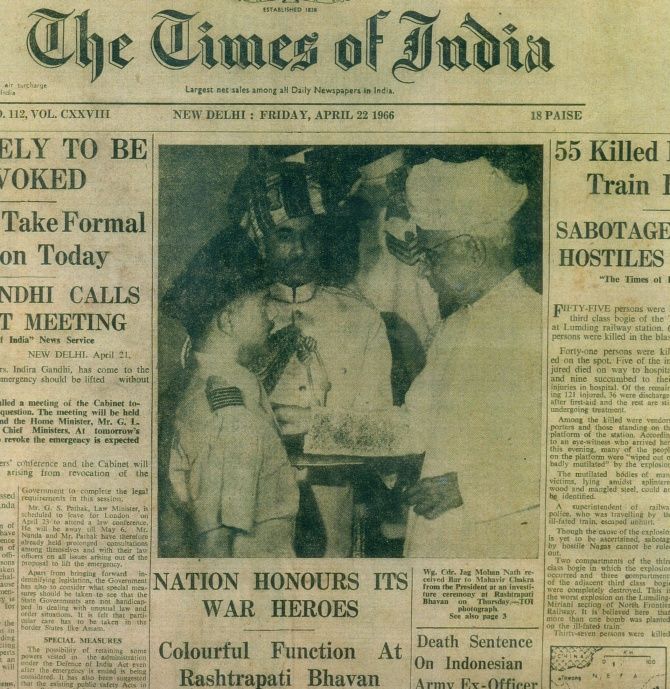
In Pathankot, the top brass of the army and air force was there, they said: "We want a reconnaissance from the north, from Lahore and then Sargodha (in Pakistan Punjab), to the south."
Do you understand that I had to operate in day time? I could not do reconnaissance and take pictures at night. I had to fly low to avoid the radar and my target was 15 to 20 miles.
Usually, I used to build up my speed, convert into height, go at 12,000 feet (to take the picture)and was staggering around.
I had 5 to 10 minutes at the most. Later, I would come back (to India).
It was not enough time for the radar to activate anything. For so many years, I did this particular exercise.
But I could not do this for this particular reconnaissance for the second front the army wanted to open.
I told them: "How can I fly for 30, 35 or 40 minutes doing this business?" If I had broken it into small (shorter) sorties, this would be alright, but it was not what I was asked for.
When I finally did it and as I was heading back towards India, I told my navigator, "We go back to India now, we have taken the picture."
I got a warning on my tail radar. The tail radar of the Camberra picks things 15 miles away. You know exactly where the other plane is going to shoot you down.
The navigator said "Sir, I saw a black spot (in the radar)." I told him, "Never mind, if it comes closer, some 5 miles away, call me up."
I thought it would be from this distance that they would launch their missile.
Starfighters needed 5 to 10 seconds to log into the heat source and then shoot its missile. With less time than this, it has no time (to adjust the target).
It means that I have been on the move and not remained steady for more than 10 or 15 seconds.
And suddenly another spot (on the radar), and then another one; total four planes (behind us)!
I don't have any time to think. I improvised, I started barrel rolls. You do loop like this (demonstrates with gesture) it is called a barrel roll.
(A barrel roll is an aerial maneuver in which an airplane makes a complete rotation on both its longitudinal and lateral axes, causing it to follow a helical path, approximately maintaining its original direction. It is sometimes described as a combination of a loop and a roll).
That way I headed towards India.
I was caught by Indian radar. My friend Wing Commander (Krishna) Dandapani (Commanding Officer of the 203 Signal Unit in Amritsar) was not even informed, as the orders had been given to me at such a short notice.
Dandapani was on his toes; he said: 'Five airplanes are coming". He thought they were all Pakistani planes.
Remember that I been in the air for some 30 minutes already. So, Dandapani sees five planes coming and suddenly four going away.
He thought there was still one Pakistani plane. The Pakistani was me.
And then, my navigator tells me: "There is another airplane coming".
I said: "But we are in our country".
So I started doing a curve, I didn't need to do barrel turns; the difference between a fighter plane and a Canberra is the latter can do tighter turns while fighter planes have to do larger turns.
It was difficult to shoot me down while turning. So they missed me and overshot (our plane). At that time, they saw the Indian marking.
They called the airfield and told them: "This airplane is ours, how can we shoot him down?"
The control tower in Pathankot confirmed: "Yes, it is our plane; he has taken off from Pathankot and has to land there". They had just realised.
With all these exercises, I run out of bloody fuel. My gauge said 'zero' and I had no other option but to land in Pathankot.
The air control said: "No, you can't land, there are planes landing in a row from Akhnur (front)."
I said "I will land between two of them".
And as I landed one of my engines copped out.
Can you imagine such a flight!
And the information which came out of it was so vital!
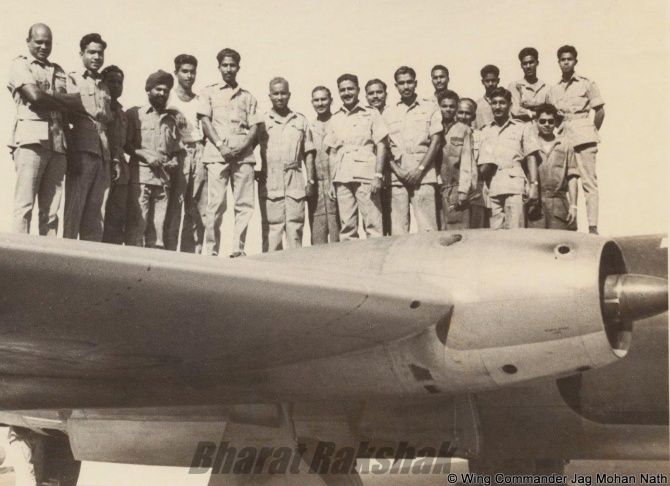
The army (authorities) could find a place called Barki to launch a counter-attack (Barki is a village that lies south-east of Lahore near the border with Punjab, India, and is connected with Lahore by the bridge over the Ichogil canal).
Later, the Indian Army withdrew by itself and the Pakistanis reinforced the place.
(The Battle of Burki (or Barki) was fought by Indian infantry and Pakistani armour in the 1965 War. The battle resulted in an Indian victory after the army captured the town on September 11, 1965. After the capture of Burki, the Indian advance continued towards Dograi, a town in the immediate vicinity of Lahore. No attempt was made to capture Lahore.)
But my flight gave them the information exactly where to go.
One particular flight gave them (the Indian Army) so much information.
You were awarded the Maha Vir Chakra for the second time for that?
The first MVC was awarded on January 1, 1962.
Though the war had not started, the reconnaissance had started, and the bar (the second MVC) was granted in September 1965.
I was the first officer of the armed forces to be awarded the MVC twice.
In 1965, General Sparrow got a bar and then four bars were given in 1971. (Major General Rajinder Singh, MVC**, nicknamed 'Sparrow' was awarded the MVC for his role during the War of 1947 and for displaying gallantry in the War of 1965).
I feel two Maha Vir Chakras should be equal to one Param Vir Chakra. It is not a joke to have two MVCs, but the government does not agree.
The Citation for the Bar to the MVC
Sqn Ldr Jag Mohan Nath, Award Date: September 1, 1965
During the Indo-Pak War 1965, Sqn Ldr Nath was again the Flight Commander with the Strategic Photo Reconnaissance Squadron flying the Canberra aircraft.
He led his unit several times over the hostile territory to obtain vital information about the enemy.
The unescorted missions, which were in the nature of reconnaissance, entailed flying long distances over the enemy territory and well-defended airfields and installations during day light.
Sqn Ldr Nath was fully aware of the risk he was running on each of these missions. Still, he chose to undertake the risky missions himself.
It was after great persuasion that he allowed his colleagues to do some risky assignments. The information gathered by him during his missions proved vitally important to Indian air effort.
The missions enabled our Air Force to attack vital enemy targets and this adversely affected enemy's war effort. Sqn Ldr Nath was awarded Bar to Mahavir Chakra for displaying courage, determination and devotion to duty.
Claude Arpi is grateful to Jagan Pillarisetti of www.Bharat-Rakshak.com for his suggestions/clarifications.

